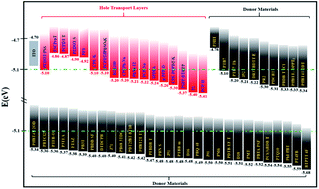Hole transport layers for organic solar cells: recent progress and prospects
Abstract
As a new generation of solid-state film cells, organic solar cells (OSCs) have become the research focus in the field of renewable energy sources, and the reported power conversion efficiencies (PCEs) have been boosted to 18%. Hole transport layer (HTL) materials, a critical component of OSCs, exert a tremendous impact on the PCE and stability of OSCs. At present, the HTL materials used in OSCs can be divided into two main categories, which are inorganic HTL materials and organic HTL materials. Although, OSCs with inorganic HTL materials can achieve satisfactory PCE, they are not suitable for large-scale commercial roll-to-roll production due to the unavoidable process of high-temperature vacuum evaporation. Recently, a great number of organic HTL materials have been designed, synthesized, and successfully applied in OSCs. Herein, we review the recent advances in organic HTL materials in single-junction OSCs and systematically discuss the relationships between the structure and properties of various HTL materials, and highlight the design rules of HTL materials for highly efficient and stable OSCs.



 Please wait while we load your content...
Please wait while we load your content...